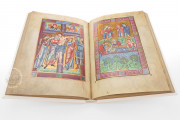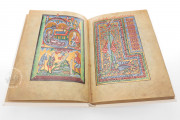With its eighteen full-page illuminations gleaming with gold, the Brandenburg Evangelary is an exquisite example of Romanesque manuscript production in northern Germany. Created around 1210 in Magdeburg for the Brandenburg Premonstratensian Cathedral Abbey, it contains the Gospel readings for the liturgical year in Latin written in a precise protogothic script with rubrication marking each reading. Decorated and historiated initials demarcate special days. Its masterful images are vehicles for emotional and spiritual contemplation and abound in rich colors and delicate details attesting to the wealth and status of Brandenburg in the early thirteenth century.
The Brandenburg Evangelary was originally bound in a jeweled cover with the central image of the Crucifixion in gold surrounded by rock crystals and later medieval enamel—a testament to the central status of the Gospel readings in medieval liturgy. It is a rare example of a manuscript that has stayed in place through the entirety of its life, created for and remaining in the Brandenburg Cathedral for the last eight centuries.
A Key Work of Northern German Book Illumination in the Twelfth Century
This sumptuous manuscript contains eighteen full-page miniatures depicting scenes from the Life of Christ. An additional ten historiated initials decorate the text, unusual in that they are enlarged to the status of miniatures in their own right.
Decorative initials appear throughout the text to demarcate special days. Their style is richly Italianate with delicate curls of acanthus and ivy often combined with figures reminiscent of classical atlantes. Its program of illumination is a marriage of a wide range of contemporary influences, from Byzantine iconography to the English and French Romanesque.
Emotion and Sacred Time in the Performance of Liturgy
The Brandenburg Evangelary is a liturgical book containing the gospel readings for the liturgical year beginning with Christmas. This allows for the manuscript’s pictorial cycle to reflect the chronology of Christ’s life, beginning with Joseph’s dream of an angel delivering the message of Mary’s divine child, continuing through Christ’s infancy, Passion, Ascension, and Pentecost.
The backgrounds of the compositions are rendered in gold denoting the sacred time and space in which the story of Christ is presented and performed throughout the liturgical year. The powerful emotional content rendered expertly by master illuminators creates a personal connection to the spiritual events depicted.
Binding description
The original jeweled binding was unfortunately lost during the Second World War, however, photographs document its appearance. In the center, a recessed golden repoussé plaque presents the Crucifixion that duplicates the same image on fol. 50r within the manuscript. The goldsmith’s cover was an external reflection of the adoration of the Gospel during the performance of the liturgy. This treatment visually linked the Word of God to the physical relics of saints contained in adorned reliquaries.
Despite this tragic loss, the manuscript itself has remained in the Brandenburg Cathedral for the last eight centuries, a testament to the immutable traditions of a center of Christian life in northern Germany.
We have 1 facsimile edition of the manuscript "Brandenburg Evangeliary": Das Brandenburger Evangelistar facsimile edition, published by Quaternio Verlag Luzern, 2020
Request Info / Price






























